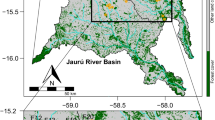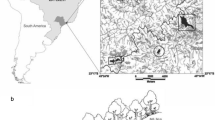Abstract
Human modification of landscapes typically results in many species being confined to small, isolated and degraded habitat fragments. While fragment size and isolation underpin many studies of modified landscapes, vegetation characteristics are less frequently incorporated. The relative influence of biogeographic (e.g. size, isolation) and vegetation parameters on assemblages is poorly understood, but critical for conservation management. In this study, a multiple hypothesis testing framework was used to determine the relative importance of biogeographic and vegetation parameters in explaining the occurrence of an assemblage of small mammals in 48 forest fragments in an agricultural landscape in south-eastern Australia. Fragment size and vegetation characteristics were consistently important predictors of occurrence across species. In contrast, fragment isolation was important for just one native species. Differing abilities of species to move through the landscape provide a reasonable explanation for these results. We conclude that for effective conservation of assemblages, it is important to: (1) consider differing responses of species to landscape change, and (2) move beyond a focus primarily on spatial attributes (size, isolation) to recognise that landscape change also has profound effects on habitat composition and quality.






Similar content being viewed by others
References
Andrén H (1994) Effects of habitat fragmentation on birds and mammals in landscapes with different proportions of suitable habitat: a review. Oikos 71:355–366. doi:10.2307/3545823
Armstrong DP (2005) Integrating the metapopulation and habitat paradigms for understanding broad-scale declines of species. Conserv Biol 19:1402–1410. doi:10.1111/j.1523-1739.2005.00117.x
Banks SC, Finlayson GR, Lawson SJ, Lindenmayer DB, Paetkau D, Ward SJ, Taylor AC (2005) The effects of habitat fragmentation due to forestry plantation establishment on the demography and genetic variation of a marsupial carnivore, Antechinus agilis. Biol Conserv 122:581–597. doi:10.1016/j.biocon.2004.09.013
Bennett AF (1987) Conservation of mammals within a fragmented forest environment: the contributions of insular biogeography and autecology. In: Saunders DA, Arnold GW, Burbidge AA, Hopkins AJM (eds) Nature conservation: the role of remnants of native vegetation. Surrey Beatty and Sons, Chipping Norton, pp 41–52
Bennett AF (1990a) Habitat corridors and the conservation of small mammals in a fragmented forest environment. Landsc Ecol 4:109–122. doi:10.1007/BF00132855
Bennett AF (1990b) Land-use, forest fragmentation and the mammalian fauna at Naringal, south-western Victoria. Aust Wildl Res 17:325–347. doi:10.1071/WR9900325
Bennett AF (1993) Microhabitat use by the long-nosed potoroo, Potorous tridactylus, and other small mammals in remnant forest vegetation of south-western Victoria. Wildl Res 20:267–285. doi:10.1071/WR9930267
Burnham KP, Anderson DR (2002) Model selection and multimodel inference: a practical information-theoretic approach. Springer, New York
Cockburn A, Scott MP, Scotts DJ (1985) Inbreeding avoidance and male-biased natal dispersal in Antechinus spp. (Marsupialia: Dasyuridae). Anim Behav 33:908–915. doi:10.1016/S0003-3472(85)80025-7
Cox MP, Dickman CR, Hunter J (2003) Effects of rainforest fragmentation on non-flying mammals of the Eastern Dorrigo Plateau, Australia. Biol Conserv 115:175–189. doi:10.1016/S0006-3207(03)00105-8
Debuse VJ, King J, House APN (2007) Effect of fragmentation, habitat loss and within-patch habitat characteristics on ant assemblages in semi-arid woodlands of eastern Australia. Landsc Ecol 22:731–745. doi:10.1007/s10980-006-9068-0
Delin AE, Andrén H (1999) Effects of habitat fragmentation on Eurasian red squirrel (Sciurus vulgaris) in a forest landscape. Landsc Ecol 14:67–72. doi:10.1023/A:1008040001801
Dickman CR (1995) Agile antechinus. In: Strahan R (ed) The mammals of Australia. Reed Books, Chatswood, pp 100–101
Donaldson A (2002) The value of linear roadside vegetation for maintaining native fauna in an agricultural landscape in south-western Victoria. Honours Dissertation, Deakin University, Melbourne
Driscoll DA (2004) Extinction and outbreaks accompany fragmentation of a reptile community. Ecol Appl 14:220–240. doi:10.1890/02-5248
Dunstan CE, Fox BJ (1996) The effects of fragmentation and disturbance of rainforest on ground-dwelling small mammals on the Robertson Plateau, New South Wales, Australia. J Biogeogr 23:187–201. doi:10.1046/j.1365-2699.1996.d01-220.x
Fahrig L (1997) Relative effects of habitat loss and fragmentation on population extinction. J Wildl Manag 61:603–610. doi:10.2307/3802168
Fischer J, Lindenmayer DB (2007) Landscape modification and habitat fragmentation: a synthesis. Glob Ecol Biogeogr 16:265–280. doi:10.1111/j.1466-8238.2007.00287.x
FitzGibbon SI, Putland DA, Goldizen AW (2007) The importance of functional connectivity in the conservation of a ground-dwelling mammal in an urban Australian landscape. Landsc Ecol 22:1513–1525. doi:10.1007/s10980-007-9139-x
Fleishman E, Ray C, Sjögren-Gulve P, Boggs CL, Murphy DD (2002) Assessing the roles of patch quality, area, and isolation in predicting metapopulation dynamics. Conserv Biol 16:706–716. doi:10.1046/j.1523-1739.2002.00539.x
Groot Bruinderink G, Van Der Sluis T, Lammertsma D, Opdam P, Pouwels R (2003) Designing a coherent ecological network for large mammals in northwestern Europe. Conserv Biol 17:549–557. doi:10.1046/j.1523-1739.2003.01137.x
Guadagnin DL, Maltchik L (2007) Habitat and landscape factors associated with neotropical waterbird occurrence and richness in wetland fragments. Biodivers Conserv 16:1231–1244. doi:10.1007/s10531-006-9127-5
Hanski I (1999) Metapopulation ecology. Oxford University Press, New York
Hobbs RJ (2001) Synergisms among habitat fragmentation, livestock grazing, and biotic invasions in southwestern Australia. Conserv Biol 15:1522–1528. doi:10.1046/j.1523-1739.2001.01092.x
Holland GJ, Bennett AF (2007) Occurrence of small mammals in a fragmented landscape: the role of vegetation heterogeneity. Wildl Res 34:387–397. http://www.publish.csiro.au/journals/wr. doi:10.1071/WR07061
Ihaka R, Gentleman R (1996) R: a language for data analysis and graphics. J Comput Graph Stat 5:299–314. doi:10.2307/1390807
Johnson JB, Omland KS (2004) Model selection in ecology and evolution. Trends Ecol Evol 19:101–108. doi:10.1016/j.tree.2003.10.013
Knight EH, Fox BJ (2000) Does habitat structure mediate the effects of forest fragmentation and human-induced disturbance on the abundance of Antechinus stuartii? Aust J Zool 48:577–595. doi:10.1071/ZO00018
Kupfer JA, Malanson GP, Franklin SB (2006) Not seeing the ocean for the islands: the mediating influence of matrix-based processes on forest fragmentation effects. Glob Ecol Biogeogr 15:8–20. doi:10.1111/j.1466-822X.2006.00204.x
Land Conservation Council (1976) Corangamite study area. Land Conservation Council, Melbourne
Lindenmayer DB, Peakall R (2000) The Tumut experiment—integrating demographic and genetic studies to unravel fragmentation effects: a case study of the native bush rat. In: Young AG, Clarke GM (eds) Genetics, demography, and the viability of fragmented populations. Cambridge University Press, Cambridge, pp 173–201
Lindenmayer DB, Cunningham RB, Pope ML (1999) A large-scale “experiment” to examine the effects of landscape context and habitat fragmentation on mammals. Biol Conserv 88:387–403. doi:10.1016/S0006-3207(98)00111-6
Luther D, Hilty J, Weiss J, Cornwall C, Wipf M, Ballard G (2008) Assessing the impact of local habitat variables and landscape context on riparian birds in agricultural, urbanised, and native landscapes. Biodivers Conserv 17:1923–1935. doi:10.1007/s10531-008-9332-5
Mac Nally R (2000) Regression and model-building in conservation biology, biogeography and ecology: the distinction between—and reconciliation of—‘predictive’ and ‘explanatory’ models. Biodivers Conserv 9:655–671. doi:10.1023/A:1008985925162
Manel S, Williams CH, Ormerod SJ (2001) Evaluating presence-absence models in ecology: the need to account for prevalence. J Appl Ecol 38:921–931. doi:10.1046/j.1365-2664.2001.00647.x
McGarigal K, Cushman SA, Neel MC, Ene E (2002) FRAGSTATS: spatial pattern analysis program for categorical maps. University of Massachusetts, Amherst. Available at www.umas.edu/landeco/research/fragstats/fragstats.html
McIntire EJB, Schultz CB, Crone EE (2007) Designing a network for butterfly habitat restoration: where individuals, populations and landscapes interact. J Appl Ecol 44:725–736. doi:10.1111/j.1365-2664.2007.01326.x
Mutze GJ (1991) Mouse plagues in south Australian cereal-growing areas. III. Changes in mouse abundance during plague and non-plague years, and the role of refugia. Wildl Res 18:593–604. doi:10.1071/WR9910593
Nupp TE, Swihart RK (2000) Landscape-level correlates of small-mammal assemblages in forest fragments of farmland. J Mammal 81:512–526. doi:10.1644/1545-1542(2000)081<0512:LLCOSM>2.0.CO;2
Pellet J, Fleishman E, Dobkin DS, Gander A, Murphy DD (2007) An empirical evaluation of the area and isolation paradigm of metapopulation dynamics. Biol Conserv 136:483–495. doi:10.1016/j.biocon.2006.12.020
Rushton SP, Ormerod SJ, Kerby G (2004) New paradigms for modelling species distributions? J Appl Ecol 41:193–200. doi:10.1111/j.0021-8901.2004.00903.x
Saunders DA, Hobbs RJ, Margules CR (1991) Biological consequences of ecosystem fragmentation: a review. Conserv Biol 5:18–32. doi:10.1111/j.1523-1739.1991.tb00384.x
Schtickzelle N, Baguette M (2004) Metapopulation viability analysis of the bog fritillary butterfly using RAMAS/GIS. Oikos 104:277–290. doi:10.1111/j.0030-1299.2004.12825.x
Soulé ME (ed) (1987) Viable populations for conservation. Cambridge University Press, New York
Spencer R-J, Cavanough VC, Baxter GS, Kennedy MS (2005) Adult free zones in small mammal populations: response of Australian native rodents to reduced cover. Austral Ecol 30:868–876. doi:10.1111/j.1442-9993.2005.01530.x
Taylor PD, Fahrig L, Henein K, Merriam G (1993) Connectivity is a vital element of landscape structure. Oikos 68:571–573. doi:10.2307/3544927
Thomas JA, Bourn NAD, Clarke RT, Stewart KE, Simcox DJ, Pearman GS, Curtis R, Goodger B (2001) The quality and isolation of habitat patches both determine where butterflies persist in fragmented landscapes. Proc R Soc Lond B Biol Sci 268:1791–1796. doi:10.1098/rspb.2001.1693
Uezu A, Metzger JP, Vielliard JME (2005) Effects of structural and functional connectivity and patch size on the abundance of seven Atlantic forest bird species. Biol Conserv 123:507–519. doi:10.1016/j.biocon.2005.01.001
Walsh C, Mac Nally R (2004) The hier.part package, version 1.0-1. Supplementary package for the R statistical program. Available at http://cran.r-project.org/
Acknowledgments
We thank the many landholders that allowed us to work on their properties. We would also like to thank all those who assisted with field work. Trapping and handling of animals was conducted under Deakin University Animal Ethics Committee approval (A15/2001) and a Department of Sustainability and Environment Research Permit (10001802). Financial support was provided by the Holsworth Wildlife Research Endowment, Deakin University, and an Australian Postgraduate Award received by G. J. Holland. The comments of an anonymous reviewer improved an earlier version of the manuscript.
Author information
Authors and Affiliations
Corresponding author
Rights and permissions
About this article
Cite this article
Holland, G.J., Bennett, A.F. Differing responses to landscape change: implications for small mammal assemblages in forest fragments. Biodivers Conserv 18, 2997–3016 (2009). https://doi.org/10.1007/s10531-009-9621-7
Received:
Accepted:
Published:
Issue Date:
DOI: https://doi.org/10.1007/s10531-009-9621-7




